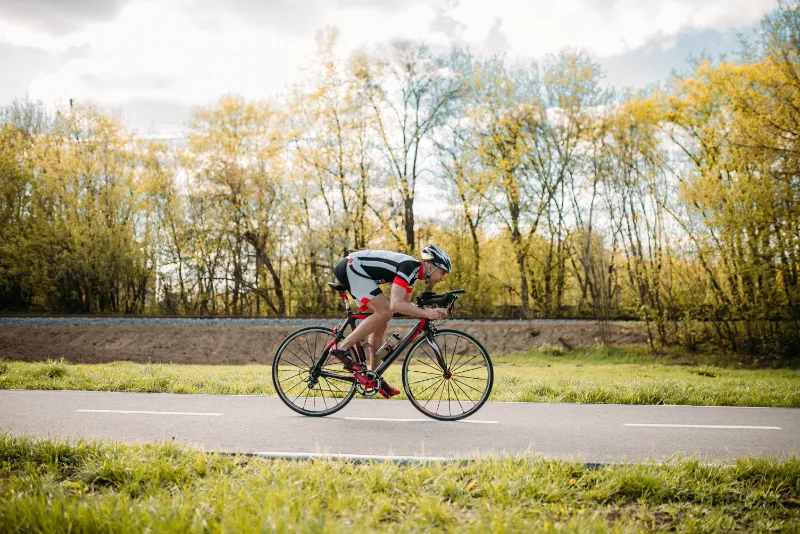How To Help Prevent Common Cycling Injuries

Lower Back Pain from Cycling:
Seeing as a lot of time is spent in a flexed, bent forward position, lower back pain is very common in cyclists. This is due to this position resulting in the back muscles being stretched, meaning that they’ll be effectively switched off, thus becoming weak. This weakness can unfortunately then translate into your everyday day life and make you more prone to other lower back problems. Not only this, this flexed position can also cause your hip muscles to become extremely tight.
It is often found that cyclists have very strong legs but weakness in their core, back muscles and upper limbs. For your back to function effectively you need to be strong everywhere, particularly around your core and hips. A strong core will also make it easier to push through your legs.
In order to protect yourself against lower back pain, we would recommend the following:
- Make sure your handlebars are set at the correct height
- Make sure to strengthen your core and upper limbs
- Stretch and loosen off your hips
- Use a spikey massage ball in your piriformis and gluteals, as well as around the muscles in your lower back
Knee Pain from Cycling:
Being such a complicated joint, there are several different areas in which people experience pain from cycling in their knees – the front and the back, as well as the inside and outside of the knee.
Pain at the front of the knee (anterior knee pain) can quite often be due to your seat being too low, which increases the bend in your knee. This bend will often contribute to your quadriceps becoming much tighter, which puts pressure through to your knee cap. Conversely, pain to the back of your knee (posterior knee pain) can often be due to your seat being too high, which puts your hamstrings on more of a stretch whilst using them.
Meanwhile, pain on the inside and outside of your knee (medial and lateral knee pain) is often caused by an incorrect cleat set up, leading to changes in your biomechanics thus causing an increase in pressure through different parts of your knee/ankle. A tight ITB (connective tissues down the side of your thigh) can also be a cause for knee pain.
If you’re currently experiencing knee pain from cycling, we would recommend the following:
- Make sure you have your cleats and seat setup correctly
- Regular stretching and massage of the muscles in your lower limbs
- Use of Kinesiology Tape for short term relief
- Use of a spikey massage ball in those tight, problematic areas
Neck Pain from Cycling:
While sitting in a flexed position, the neck often finds itself in a hyperextended position. This causes the neck muscles to become shortened and tight and also closes down the joints in the neck, which can cause irritation and inflammation. As such, it is important to make sure you’re getting 60% of load through the rear of your bike and 40% through the front, making sure the handle bar isn’t too low.
To protect against neck pain, then, we recommend the following for cyclists:
- Raising handle bars to a good height
- Regular stretching, massage, and use of a spikey ball in the muscles around your neck
- Strengthening around your neck, shoulders and thoracic region
Foot and Ankle Pain from Cycling:
Achilles tendinopathy is an overuse injury often experienced by cyclists. This is typically caused by having your seat too high. By having your seat too high, this can cause your foot to be in a pointed position (plantar flexed), which causes constant, repetitive contraction and overuse of the calf muscle. The symptoms of this include stiffness and tenderness of the achilles (maybe even a lump), along with variable pain whilst cycling and performing other activity.
For anyone worried about this type of injury, we would recommend the following:
- Adjusting your seat if it is too high
- Ensuring you stretch and release your calf muscle if they’re too tight
- Strengthening your calf muscle (eccentrically if confirmed Achilles tendinopathy)
Essential Advice for Avoiding Cycling Injuries:
We’ve covered a lot here, but in terms of a quick summary on what to do to stay on the bike and off the treatment table, these are our top tips:
- Make sure your bike is at the correct height for you
- Ensure you have the correct cleat set up
- Make sure to strengthen your core, both anteriorly and posteriorly
- Perform regular stretching and release work of problem areas
- Warm up and cool down effectively before and after getting on the bike
On top of these top tips, make sure to check out our other recent article on strength and condition exercises for cyclists, as well as our post on stretching exercises for cyclists.
For more information, or if you know you need to book a course of physiotherapy treatment to get back onto the bike without experiencing pain, then get in touch with us today.

